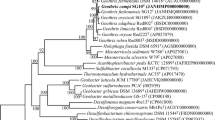Abstract
Propionate can be directly oxidized anaerobically with sulfate as e-acceptor at haloalkaline conditions either incompletely to acetate (an example is Desulfobulbus alkaliphilus), or completely (for example by the members of genus Desulfonatronobacter). An enrichment with propionate at methanogenic conditions (without sulfate) inoculated with mixed sediments from hypersaline soda lakes in Kulunda Steppe (Altai, Russia) resulted in a domination of a new member of Syntrophobacteraceae (Deltaproteobacteria) in a consortium with the haloalkaliphilic lithotrophic methanogen Methanocalculus alkaliphilus. Transfer of this culture to a medium containing propionate as e-donor and sulfate as e-acceptor resulted in a disappearance of the methanogen and sulfide formation by the bacterial component, finally isolated into a pure culture at these conditions. Strain APr1 formed a distinct phylogenetic lineage within the family Syntrophobacteraceae, being equally distant from its members at the genus level. Phenotypically, strain APr1 resembled the species of the genus Syntrophobacter with substrate spectrum restricted to propionate and propanol utilized with sulfate, sulfite and thiosulfate as the e-acceptors. Propionate is oxidized incompletely to acetate. It is a moderately salt-tolerant (max. 1.2 M Na+) obligate alkaliphile (pH opt. 10). The isolate is proposed to be classified as a new candidate genus and species ‘Candidatus Desulfonatronobulbus propionicus’.



Similar content being viewed by others
References
Foti M, Sorokin DY, Lomans B, Mussman M, Zakharova EE, Pimenov NV, Kuenen JG, Muyzer G (2007) Diversity, activity and abundance of sulfate-reducing bacteria in saline and hypersaline soda lakes. Appl Environ Microbiol 73:2093–2100
Gregoire P, Fardeau M-L, Guasco S, Lagiere J, Cambar J, Michotey V, Bonin P, Ollivier B (2012) Desulfosoma profundi sp. nov., a thermophilic sulfate-reducing bacterium isolated from a deep terrestrial geothermal spring in France. Ant Leeuwenhoek 101:595–602
Kuever J (2014) The family Syntrophobacteraceae. In: Rosenberg E et al (eds) The Prokaryotes—Deltaproteobacteria and Epsilonproteobacteria. Springer, Berlin, p 45
Lane DJ (1991) 16S/23S rRNA sequencing. In: Stackebrandt E, Goodfellow M (eds) Nucleic acid techniques in bacterial systematics. Wiley, Chichester, pp 115–177
Marmur J (1961) A procedure for isolation of DNA from microorganisms. J Mol Biol 3:208–214
Marmur J, Doty P (1962) Determination of the base composition of deoxyribonucleic acid from microorganisms. J Mol Biol 5:109–118
Sorokin DY, Detkova EN, Muyzer G (2010) Propionate and butyrate dependent bacterial sulfate reduction at extremely haloalkaline conditions and description of Desulfobotulus alkaliphilus sp. nov. Extremophiles 14:71–77
Sorokin DY, Kuenen JG, Muyzer G (2011) The microbial sulfur cycle in soda lakes. Front Microbial Physiol 2:44
Sorokin DY, Panteleeva AN, Tourova TP, Muyzer G (2012) Haloalkaliphilic heterotrophic sulfate-reducing bacteria from soda lakes and description of Desulfonatronobacter acidivorans gen. nov., sp. nov., and Desulfobulbus alkaliphilus sp. nov. Int J Syst Evol Microbiol 62:2107–2113
Sorokin DY, Banciu H, Robertson LA, Kuenen JG, Muntyan MS, Muyzer G (2013) Halophilic and haloalkaliphilic sulfur-oxidizing bacteria from hypersaline habitats and soda lakes. In: Rosenberg E et al (eds) The Prokaryotes—Prokaryotic Physiology and Biochemistry. Springer, Berlin, pp 530–555
Sorokin DY, Berben T, Melton ED, Overmars L, Vavourakis C, Muyzer G (2014a) Microbial diversity and biogeochemical cycling in soda lakes. Extremophiles 18:791–809
Sorokin DY, Abbas B, Tourova TP, Bumazhkin BK, Kolganova TV, Muyzer G (2014b) Sulfate-dependent acetate oxidation at extremely natron-alkaline conditions by syntrophic associations from hypersaline soda lakes. Microbiology 160:723–732
Sorokin DY, Banciu HA, Muyzer G (2015a) Functional microbiology of soda lakes. Curr Opin Microbiol 25:88–96
Sorokin DY, Chernyh NA, Poroshina MN (2015b) Desulfonatronobacter acetioxydans sp. nov.,—a first acetate-oxidizing extremely salt-tolerant alkaliphilic sulfate-reducing bacterium from a hypersaline soda lake. Extremophiles 19:899–907
Sorokin DY, Abbas BA, Sinninghe Damsté JS, Sukhacheva MV, van Loosdrecht. MCM (2015c) Methanocalculus alkaliphilus sp. nov., and Methanosalsum natronophilus sp. nov., novel haloalkaliphilic methanogens from hypersaline soda lakes. Int J Syst Evol Microbiol 65:3739–3745
Sorokin DY, Abbas B, Geleijnse M, Pimenov NV, Sukhacheva MV, van Loosdrecht MCM (2015d) Methanogenesis at extremely haloalkaline conditions in soda lakes of Kulunda Steppe (Altai, Russia). FEMS Microbiol Ecol. doi:10.1093/femsec/fiv016
Sorokin DY, Abbas B, Geleijnse M, Kolganova TV, Kleerebezem R, van Loosdrecht MCM (2016) Syntrophic associations from hypersaline soda lakes converting organic acids and alcohols to methane at extremely haloalkaline conditions. Environ Microbiol. doi:10.1111/1462-2920.13448
Tamura K, Stecher G, Peterson D, Filipski A, Kumar S (2013) MEGA6: molecular evolutionary genetics analysis version 6.0. Mol Biol Evol 30:2725–2729
Trüper HG, Schlegel HG (1964) Sulfur metabolism in Thiorhodaceae. 1. Quantitative measurements on growing cells of Chromatium okenii. Antonie Van Leeuwenhoek 30:225–238
Wagner M, Roger AJ, Flax JL, Brusseau GA, Stahl DA (1998) Phylogeny of dissimilatory sulfite reductases supports an early origin of sulphate respiration. J Bacteriol 180:2975–2982
Zhilina TN, Zavarzin GA, Rainey FA, Pikuta EN, Osipov GA, Kostrikina NA (1997) Desulfonatronovibrio hydrogenovorans gen. nov., sp. nov., an alkaliphilic, sulfate-reducing bacterium. Int J Syst Bacteriol 47:144–149
Zhilina TN, Zavarzina DG, Kolganova TV, Tourova TP, Zavarzin GA (2005) “Candidatus Contubernalis alkalaceticum,” an obligately syntrophic alkaliphilic bacterium capable of anaerobic acetate oxidation in a coculture with Desulfonatronum cooperativum. Microbiology 74:695–703 (Moscow, English Translation)
Acknowledgments
This work was supported by the Russian Foundation for Basic Research (RFBR (Grant 16-04-00035) and the Gravitation SIAM Grant 24002002 (Dutch Ministry of Education and Science) to DS.
Author information
Authors and Affiliations
Corresponding author
Additional information
Communicated by A. Oren.
Nucleotide sequence accession number GenBank/EMBL accession numbers of the 16S rRNA and dsrA gene sequences determined in this study are KU681311 and KX756667, respectively.
Electronic supplementary material
Below is the link to the electronic supplementary material.
Rights and permissions
About this article
Cite this article
Sorokin, D.Y., Chernyh, N.A. ‘Candidatus Desulfonatronobulbus propionicus’: a first haloalkaliphilic member of the order Syntrophobacterales from soda lakes. Extremophiles 20, 895–901 (2016). https://doi.org/10.1007/s00792-016-0881-3
Received:
Accepted:
Published:
Issue Date:
DOI: https://doi.org/10.1007/s00792-016-0881-3




